Geotechnical Engineering What Is It and Just How It Makes Certain Safe and Stable Structures
Geotechnical Engineering What Is It and Just How It Makes Certain Safe and Stable Structures
Blog Article
Exactly How Consulting Civil Design Firms Add To Effective Task Monitoring and Layout Execution
Consulting civil design firms are essential to the success of building tasks, merging technological efficiency with critical oversight. By concentrating on design optimization and risk reduction, these firms ensure that jobs are not just viable yet likewise lasting and cost-effective.
Role of Civil Engineers
Recognizing the role of civil designers is essential for the successful administration of building and construction tasks. Civil designers serve as the foundation of infrastructure advancement, making certain that jobs are made and performed to satisfy security, sustainability, and functionality requirements. Their know-how includes numerous facets of design, consisting of structural, ecological, and geotechnical specialties.
Civil designers are accountable for conducting usefulness researches, which analyze the stability of proposed jobs by analyzing economic, technical, and ecological aspects. They establish thorough blueprints and requirements, incorporating ingenious solutions to optimize products and resources. During the building and construction phase, civil engineers look after the job, collaborating with architects, stakeholders, and contractors to ensure adherence to develop specs and governing needs.

Job Planning Methods
Efficient job preparation techniques are crucial for making sure that building and construction tasks are implemented efficiently and successfully. Consulting civil design firms play a vital function in this procedure by utilizing detailed planning approaches that deal with various project phases. Originally, a comprehensive assessment of project scope and client needs is performed, enabling for the identification of vital milestones and deliverables.
Furthermore, these companies use tools such as Gantt charts and task administration software application to develop in-depth timelines, allowing reliable scheduling of jobs and resource allotment. This organized technique helps to anticipate possible traffic jams and allot essential sources proactively. Threat management is another vital element; firms perform risk analyses to identify possible problems that can develop during the job's lifecycle, carrying out mitigation methods to reduce disruptions.
Furthermore, stakeholder engagement is highlighted throughout the planning phase. Routine interaction with clients, specialists, and neighborhood authorities guarantees that all events are lined up with task objectives and timelines. By incorporating these approaches, getting in touch with civil engineering firms enhance the chance of job success, making certain adherence to budget constraints and regulative needs while cultivating a collaborative environment.
Layout Optimization Strategies
Layout optimization strategies are crucial for boosting the performance and sustainability of civil design tasks. These strategies include the methodical analysis of style criteria to accomplish the finest feasible end results while minimizing costs and source use. By using sophisticated computational devices and algorithms, engineers can evaluate various style options and select one of the most efficient options based upon specific job requirements.
One commonly used method is parametric design, which enables for the manipulation of design variables to observe their influence on total job performance. This iterative process causes ingenious services that not only fulfill practical demands but likewise follow environmental anchor criteria. In addition, methods such as value design concentrate on maximizing task aspects to make the most of worth while minimizing unnecessary prices.
Furthermore, the combination of Building Details Modeling (BIM) helps with better partnership among stakeholders, making it possible for real-time changes and enhancements to layouts. This alternative sight promotes a comprehensive understanding of the job, leading to notified decision-making. Ultimately, reliable design optimization strategies result in boosted project timelines, lowered waste, and boosted structural efficiency, contributing to the general success of civil design ventures.
Threat Management Approaches
Threat management techniques are crucial in ensuring the successful distribution of civil engineering tasks, as they help determine, analyze, and reduce prospective hazards that could affect task end results. Effective danger management is a systematic procedure that entails the recognition of risks, evaluation of their likelihood and effect, and the growth of approaches to address them.
Consulting civil engineering firms typically utilize a mix of measurable and qualitative risk assessment techniques (geotechnical engineering companies in south africa). Qualitative techniques, such as conceptualizing sessions and skilled meetings, aid collect understandings on potential risks from different stakeholders. Alternatively, measurable strategies entail analytical evaluation and modeling to determine the probability and possible impact of identified risks
Once risks are assessed, firms implement mitigation techniques, which may include danger avoidance, transfer, reduction, or acceptance. This could involve redesigning task parts to remove dangers or protecting insurance policy to counter prospective monetary losses. Continuous monitoring and testimonial of dangers throughout the job lifecycle are also necessary, enabling timely changes to take the chance of administration techniques as new threats arise.
Collaborative Interaction Practices
Enhancing project end results with collective interaction methods is essential for seeking advice from civil engineering companies. Efficient communication cultivates a culture of openness and trust among stakeholders, which is necessary for the effective execution of design projects. By applying structured communication channels, companies can make certain that all events-- clients, contractors, and employee-- are lined up on task deliverables, goals, and timelines.
Regular conferences, both casual and formal, help with the exchange of ideas and responses, permitting real-time analytic and decision-making. Utilizing joint tools such as job monitoring software application encourages paperwork and monitoring of progress, while allowing instantaneous access to crucial information.
Additionally, active listening and open discussion are crucial components in a collective setting. By valuing varied point of views, companies can introduce and adjust designs that satisfy both technological needs and customer assumptions. Additionally, promoting a team-oriented environment decreases misunderstandings and elevates the general top quality of work.

Verdict
In conclusion, seeking advice from civil engineering companies are essential to effective project straight from the source administration and layout application. Inevitably, the knowledge and methodologies utilized by getting in touch with civil engineers dramatically contribute to attaining project goals while lessening costs and making best use of resource usage.

In final thought, seeking advice from civil engineering companies are essential to effective job monitoring and style implementation.
Report this page